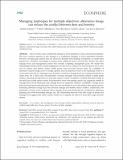Managing landscapes for multiple objectives : alternative forage can reduce the conflict between deer and forestry
Abstract
Deer (Cervidae) cause considerable damage to forest plantations, crops, and protected habitats. The most common response to this damage is to implement strategies to lower population densities. However, lowering deer density may not always be desirable from hunting, recreational, or conservation perspectives. Therefore, knowledge is needed about additional factors beyond deer density that affect damage levels, and management actions that consider competing management goals. We studied the relationships between levels of bark-stripping by red deer (Cervus elaphus) on Norway spruce (Picea abies) and (1) relative deer density indices (pellet group count and deer harvest data), (2) availability of alternative natural forage (cover of forage species) and (3) proportion forest in the landscape, both at a forest stand scale and at a landscape scale. Extensive variation in damage level was evident between the six study areas. On a stand scale, the proportion of spruce damaged was positively related to pellet group density, indicating the importance of local deer usage of stands. In addition, available alternative forage in the field layer within spruce stands and proportion forest surrounding stands was negatively related to damage level. On the landscape scale, damage level was negatively related to availability of forage in the field and shrub layers and proportion forest, but was not related to any of the relative deer density indices. Increasing alternative forage may thus decrease damage and thereby reduce conflicts. Additionally, the proportion of forest in the landscape affects damage levels and should thus be considered in landscape planning and when forecasting damage risk. The relationship between local deer usage of stands and damage level suggests that future studies should try to separate the effects of local deer usage and deer density.
Citation
Jarnemo , A , Minderman , J , Bunnefeld , N , Zidar , J & Mansson , J 2014 , ' Managing landscapes for multiple objectives : alternative forage can reduce the conflict between deer and forestry ' , Ecosphere , vol. 5 , no. 8 , 97 . https://doi.org/10.1890/ES14-00106.1
Publication
Ecosphere
Status
Peer reviewed
ISSN
2150-8925Type
Journal article
Description
The study was financed by The Swedish Environmental Protection Agency and The Royal Swedish Academy of Agriculture and Forestry through Stiftelsen Carl-Fredrik von Horns fond.Collections
Items in the St Andrews Research Repository are protected by copyright, with all rights reserved, unless otherwise indicated.

